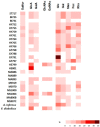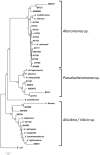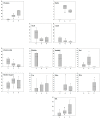Bioprospecting for Exopolysaccharides from Deep-Sea Hydrothermal Vent Bacteria: Relationship between Bacterial Diversity and Chemical Diversity
- PMID: 28930185
- PMCID: PMC5620654
- DOI: 10.3390/microorganisms5030063
Bioprospecting for Exopolysaccharides from Deep-Sea Hydrothermal Vent Bacteria: Relationship between Bacterial Diversity and Chemical Diversity
Abstract
Many bacteria biosynthesize structurally diverse exopolysaccharides (EPS) and excrete them into their surrounding environment. The EPS functional features have found many applications in industries such as cosmetics and pharmaceutics. In particular, some EPS produced by marine bacteria are composed of uronic acids, neutral sugars, and N-acetylhexosamines, and may also bear some functional sulfate groups. This suggests that they can share common structural features with glycosaminoglycans (GAG) like the two EPS (HE800 and GY785) originating from the deep sea. In an attempt to discover new EPS that may be promising candidates as GAG-mimetics, fifty-one marine bacterial strains originating from deep-sea hydrothermal vents were screened. The analysis of the EPS chemical structure in relation to bacterial species showed that Vibrio, Alteromonas, and Pseudoalteromonas strains were the main producers. Moreover, they produced EPS with distinct structural features, which might be useful for targeting marine bacteria that could possibly produce structurally GAG-mimetic EPS.
Keywords: GAG; exopolysaccharides; glycopolymers; marine bacteria; production; sulfate.
Conflict of interest statement
The authors declare no conflict of interest.
Figures




Similar articles
-
Deep-sea Hydrothermal Vent Bacteria as a Source of Glycosaminoglycan-Mimetic Exopolysaccharides.Molecules. 2019 May 1;24(9):1703. doi: 10.3390/molecules24091703. Molecules. 2019. PMID: 31052416 Free PMC article.
-
Characterization of New Oligosaccharides Obtained by An Enzymatic Cleavage of the Exopolysaccharide Produced by the Deep-Sea Bacterium Alteromonas infernus Using its Cell Extract.Molecules. 2019 Sep 22;24(19):3441. doi: 10.3390/molecules24193441. Molecules. 2019. PMID: 31546751 Free PMC article.
-
Exopolysaccharides produced by marine bacteria and their applications as glycosaminoglycan-like molecules.Front Chem. 2014 Oct 8;2:85. doi: 10.3389/fchem.2014.00085. eCollection 2014. Front Chem. 2014. PMID: 25340049 Free PMC article. Review.
-
Deep-sea hydrothermal vents: a new source of innovative bacterial exopolysaccharides of biotechnological interest?J Ind Microbiol Biotechnol. 2002 Oct;29(4):204-8. doi: 10.1038/sj.jim.7000298. J Ind Microbiol Biotechnol. 2002. PMID: 12355321
-
Bacterial exopolysaccharides from extreme marine habitats: production, characterization and biological activities.Mar Drugs. 2010 Jun 3;8(6):1779-802. doi: 10.3390/md8061779. Mar Drugs. 2010. PMID: 20631870 Free PMC article. Review.
Cited by
-
Contributions of Women in Recent Research on Biopolymer Science.Polymers (Basel). 2022 Mar 30;14(7):1420. doi: 10.3390/polym14071420. Polymers (Basel). 2022. PMID: 35406293 Free PMC article. Review.
-
Exploring Codon Adjustment Strategies towards Escherichia coli-Based Production of Viral Proteins Encoded by HTH1, a Novel Prophage of the Marine Bacterium Hypnocyclicus thermotrophus.Viruses. 2021 Jun 23;13(7):1215. doi: 10.3390/v13071215. Viruses. 2021. PMID: 34201869 Free PMC article.
-
Exploring the Exopolysaccharide Production Potential of Bacterial Strains Isolated from Tunisian Blue Crab Portunus segnis Microbiota.Molecules. 2024 Feb 7;29(4):774. doi: 10.3390/molecules29040774. Molecules. 2024. PMID: 38398526 Free PMC article.
-
Marine versus Non-Marine Bacterial Exopolysaccharides and Their Skincare Applications.Mar Drugs. 2023 Nov 7;21(11):582. doi: 10.3390/md21110582. Mar Drugs. 2023. PMID: 37999406 Free PMC article. Review.
-
Genomic basis and functional characterization of the exopolysaccharide production by a thermotolerant Bacillus isolated from Tolhuaca hot spring.Front Microbiol. 2025 Aug 4;16:1622325. doi: 10.3389/fmicb.2025.1622325. eCollection 2025. Front Microbiol. 2025. PMID: 40831643 Free PMC article.
References
LinkOut - more resources
Full Text Sources
Other Literature Sources

